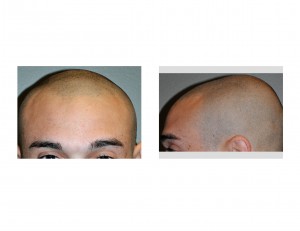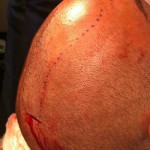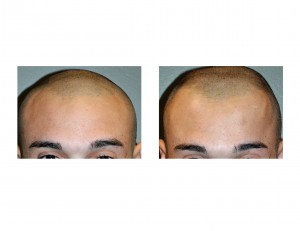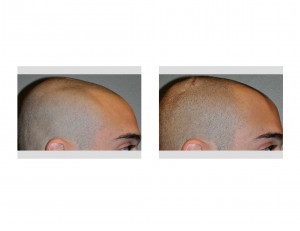Background: The shape of one’s skull is not often thought of as a major cosmetic issue. Much of this is because it is largely hidden by hair in most women and in many young men. But with hair loss in men and the contemporary hairstyle of total scalp shaving, the shape of one’s skull and upper forehead can take down a more dominant visible role. The overall size of the skull is actually greater in surface area than that of one’s face. And, unlike the face, it is generally desirous to be more of a smooth oval rather than have a lot of indentations and irregularities.
Reshaping of one’s skull can be done by either bone reduction or augmentation by onlay materials. By far, more significant changes can be made in the shape of an adult’s skull through addition rather than subtraction. Such cranioplasty procedures have been historically done through an open scalp (coronal) approach. By making a long transverse scalp incision, the scalp tissues can be widely elevated providing wide open exposure and an unobstructed working field. When one has a skull deformity as a sequelae of a prior neurosurgery or craniofacial procedure, the use of a pre-existing scalp incision makes the decision easy to proceed with skull contouring. In the absence of a prior scalp scar, however, the decision to undergo any form of skull reshaping is complicated by the scar’s cosmetic trade-off.

These parasagittal skull grooves could be easily augmented through a traditional open cranioplasty approach. Understandably he did not want the scalp scar given the modest nature of the skull problem. An alternative approach of an injectable cranioplasty procedure was devised that could be done through very small incision but yet could add material over the entire lemgth of the skull defects. Such an approach, while not possible with the use of traditional cranioplasty materials such as acrylic and hydrozyapatite, can be done using the newly FDA-approved Kryptonite bone cement.


For more modest skull contour deformities where a long scalp incision would be cosmetically unacceptable, the injectable cranioplasty method is a viable method. It is made possible with the flow characteristics of Kryptonite bone cement that have not previously existed with prior cranioplasty materials.
Highlights:
1) Skull irregularities and contour depressions have traditionally used an open scalp incision with its own cosmetic scar trade-off.
2) Injectable cranioplasty uses very small incisions that can fill in a large surface area through a long flexible filler tube. It is a procedure that is technique sensitive and intimate working knowledge of how the Kryptonite material flows and sets, and the time frame on which it happens, is needed to ensure a good result.
3)Cosmetic skull reshaping by augmentation is now possible with the minimally invasive cranioplasty (MIC) procedure. Further work is needed to define the procedure to avoid undercorrection and, most significantly, any risk of overcorrection.
Dr. Barry Eppley
Indianapolis, Indiana




